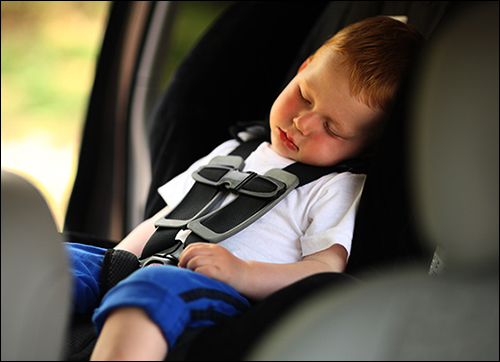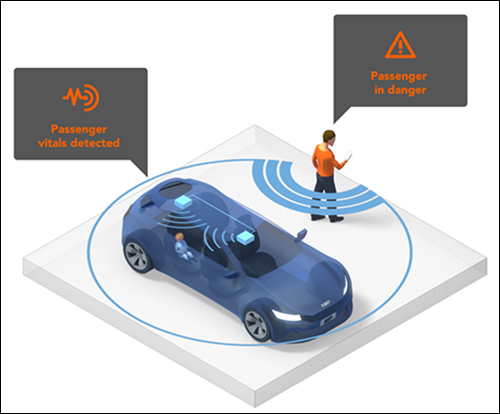Every summer, it seems, serious incidents involving children or animals left inside parked cars that overheat make the headlines. In an effort to reduce the risks of vulnerable occupants being exposed to heatstroke, car manufacturers are exploring ways to alert drivers. When deployed as a component of a child presence detection (CPD) system, ultra-wideband (UWB), an emerging technology in the automotive industry, can generate alerts if occupants are detected inside parked cars.

Small children are particularly vulnerable when left inside parked cars.
Parked Cars Heat Up Very Quickly
With its metal shell and synthetic internal fittings, the heat inside a parked car rises surprisingly quickly. High cabin temperatures can pose a real danger to vehicle occupants on a hot day. These life-threatening conditions can sometimes arise out of the blue. Even when outside temperatures are relatively mild, at 61 degrees Fahrenheit (16.1 degrees Celsius), it can take less than an hour for internal temperatures to build up to 105 degrees Fahrenheit (40.5 degrees Celsius). On a hot, mid-summer day, it can take only a matter of minutes.
Small children are particularly vulnerable when left inside parked cars, since they are more susceptible than adults to the effects of heat exposure. Infants and toddlers can rapidly become dehydrated and potentially suffer severe medical complications if their core body temperature reaches 104 degrees Fahrenheit (40 degrees Celsius). At body temperatures of 107 degrees Fahrenheit (41.7 degrees Celsius), it is even possible for a child to die.
The Dangers Are Widely Recognized
Various non-profit and consumer-advocacy groups, including KidsAndCars.org and NoHeatStroke.org, are working to raise awareness of these dangers. Both organizations track and report on vehicle-related injuries involving children, and their combined findings offer insight into the picture in the United States—and, by implication, on a global basis.
Vehicle-related heatstroke is responsible for the deaths of around 38 children in the United States every year. After crashes, it is the leading cause of vehicular death for kids ages 14 and younger. More than 85 percent of these deaths are in the three-and-under age group. Children at this age are very often strapped into safety seats in the rear, which can be difficult to see from the driver’s seat, sometimes leading to a situation in which a driver leaves a car unaware of the presence of a sleeping infant.
While children do sometimes climb into unlocked parked cars on their own without the knowledge of parents or guardians, they are more often left inside unintentionally. The occurrence of an unexpected event, over-familiarity with a regular drive or miscommunication between parents can all lead to a sleeping child being left inside the car.
Technology Offers a Solution

Marc Robaszkiewicz
The automotive industry is taking a proactive role in reducing such tragic deaths, through the innovative use of technology. In Europe, the European New Car Assessment Program (Euro NCAP) has specifically addressed the problem through its five-star safety-rating system. This system awards rating points to vehicles that feature technologies able to “detect a child left alone in a car and alert the owner and/or the emergency services, to avoid heatstroke fatalities.” Since Euro NCAP has a high profile within the industry, strongly influencing the features designed by automakers into their vehicles, this change can be expected to increase the adoption of occupant presence detection systems.
The main purpose of a CPD system is to detect signs of life in a parked vehicle and generate an alert when required. The CPD interacts with the vehicle’s instrumentation to signal the presence of an occupant after the driver has left and locked the car. The system can alert the driver using various means, including a warning sound, an emergency light or a text message, and the alert is then canceled once the vehicle is unlocked again.
In early CPD systems, 3D ultrasound sensors mounted in the vehicle scanned the cabin, generating acoustic waves that were reflected by any objects in the car. These reflected waveforms were analyzed using digital signal processing techniques; with this method, however, system accuracy could be compromised by external vibration and noise. Radar, on the other hand, scans with electromagnetic waves, which are much less susceptible to noise vibrations, giving more accurate results. UWB technology, which enables secure ranging and short-range radar, is seen as an attractive option for CPD systems.
UWB Radar Has Particular Advantages
UWB combines two techniques, time-of-flight (ToF) and Doppler effect, to detect signs of life within a vehicle. With ToF, transmitted impulses are reflected by objects and the distance is calculated by measuring the roundtrip time. When an object is moving, the reflected electromagnetic wave undergoes a frequency shift—the Doppler effect—and this shift can be measured to calculate the velocity of the moving object.
Two specific properties of UWB underpin its attractiveness as a potential technology for child-presence detection systems. Because it operates at relatively low frequencies, in the 6 to 8 GHz range, UWB signals are not blocked as much by materials inside the car, such as metal barriers and car seats, and can scan through clothes or blankets.
UWB’s highly precise location, distance and velocity measurements are ideal for signs-of-life detection applications. The technology has been proven in search-and-rescue operations, detecting casualties behind walls or buried under rubble, and is used by medical practitioners for non-contact measurement of vital signs. UWB’s ability to accurately detect the smallest of movements makes it ideally placed to detect the presence of a sleeping infant in the rear of a car.
In-Cabin UWB Radar

A UWB Radar child presence detection system
UWB’s main property is to create spatial awareness, enabling people and objects to be located in relation to an automobile. It’s an emerging technology within the automotive industry, and several potential use cases have been identified, including vehicle access and secure remote parking via smartphone, automated trailer-hitch activation, automated valet parking, hands-free parking lot access and drive-thru payments.
NXP has experience with in-car technologies and supports the development of automotive UWB solutions. A founding member of FiRa, a consortium that aims to grow the UWB technology ecosystem, the company is represented on the board of the cross-industry Car Connectivity Consortium, which focuses on smartphone-to-car connectivity solutions. Its Trimension portfolio offers UWB options enabling fine-ranging and sensing for automotive, mobile and Internet of Things (IoT) applications, and these solutions support such applications as kick sensors for opening a vehicle’s trunk.
By detecting the presence of occupants, UWB-based CPD systems can enable automakers to enhance safety in their vehicles, meeting Euro NCAP’s five-star safety ratings. CPD systems are just the beginning, however, as in-cabin UWB radar has the potential to support other in-car health-monitoring use cases as well.
Marc Robaszkiewicz is an NXP marketing manager with eight years of experience in the semiconductor industry. He holds a master’s degree in RF engineering, as well as a Master of Business Administration. Throughout his professional career, he has worked on standard products (diodes and transistors), products for in-vehicle networking (CAN, LIN and Ethernet) and products for secure car access (UHF and UWB transceivers). As a product marketing manager, he is responsible for NXP’s automotive UWB radar offerings.


